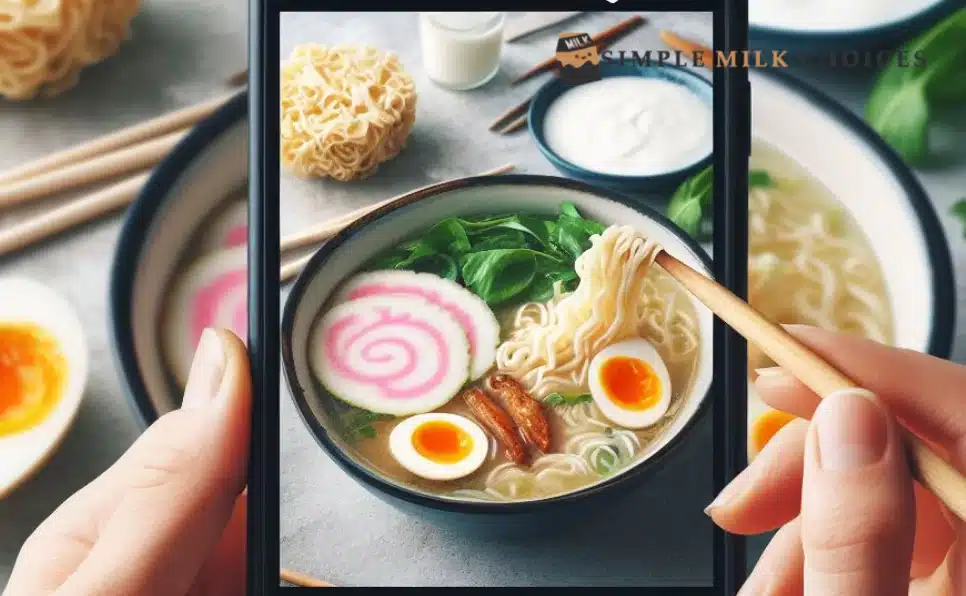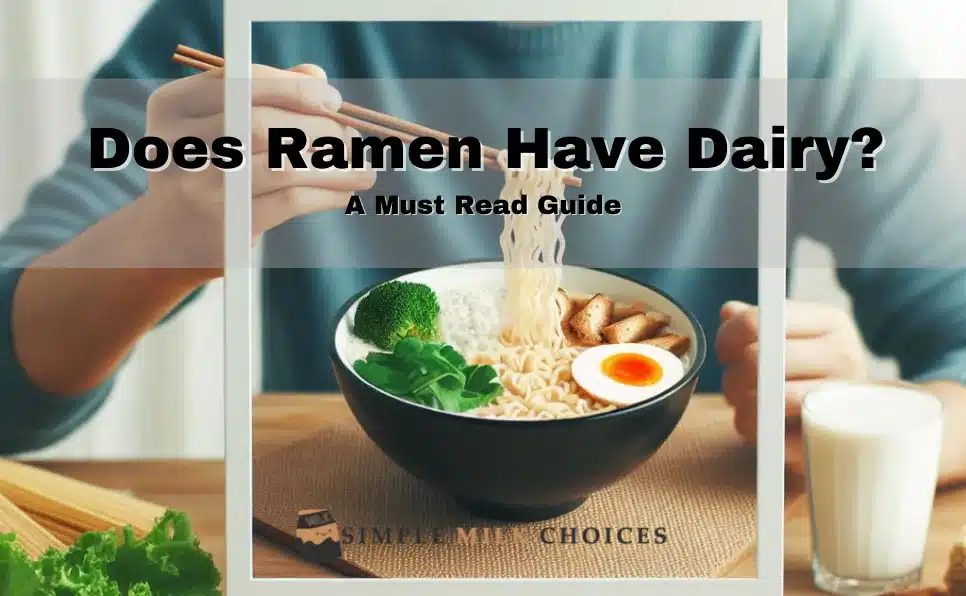Ramen isn’t simply a dinner; it’s a social symbol. Starting in Japan, this noodle soup flaunts a rich history and different varieties. Its establishment lies in four essential components: toppings, seasonings, noodles, and broth.
Ramen comprises different parts like noodles, stock, ingredients, and flavors. The discussion essentially centers around whether any of these parts, particularly the stock and certain garnishes, contain dairy or dairy-inferred ingredients.
While examining the stock, which is the fluid base of the soup, a few sorts of ramen, for example, tonkotsu, may have a rich or smooth appearance, prompting the doubt that dairy may be utilized in its planning. Different stocks, like shoyu or miso, however, might not regularly incorporate dairy.
Sauces and condiments, for example, are among the toppings and seasonings that are scrutinized in ramen. While most ingredients like meats, vegetables, and kelp are generally without dairy, certain added substances or sauces might actually contain dairy, representing a worry for people who are mindful about dairy utilization.
The Ingredients of Divulging Ramen
- Noodles
- Broth
- Garnish
- Seasonings
Noodles
These are the long, squiggly strands that guzzle up with each nibble. Straightforward ingredients like flour, water, a touch of salt, and something many refer to as kansui (pronounced “kan-sue-ee”) typically constitute their production. The unique texture and variation of the noodles attribute themselves to the remarkable mineral known as kansui. Which is superior? Most of the time, these noodles are dairy-free!
Broth
Consider the stock in the soup’s heart. It gives ramen its heartfelt taste. Presently, this is where things get fascinating. A few stocks are absolutely sans dairy, similar to the ones made with soy sauce (shoyu) or miso glue. Yet others, similar to the smooth tonkotsu stock, could sneak in dairy or milk-based stuff to make them rich and smooth.
Garnish
If your bowl of ramen were a can of paint, these garnishes would be the vivid paints that give it taste and color. A variety of toppings, including boiled eggs, seaweed, bamboo shoots, green onions, and pork cuts known as chashu, adorn the dish. These ingredients add various preferences and surfaces to your ramen. The best part is that most of these toppings are dairy-free, so it’s great for those who don’t like dairy.
Seasonings
Seasonings are like spices that give your ramen a great and different taste. They incorporate things like soy sauce, miso glue, and stew oil. These flavors acquire special flavors from the stock and ingredients. They normally don’t contain dairy; however, it’s crucial to really take a look at the marks or inquire as to whether you’re making ramen at home or requesting it from an eatery.
Also Read: Do Bagels Have Dairy?

Broth: The Dairy Predicament's Focal Point
The fluid part, or the soup, is known as the stock when discussing ramen. It gives ramen its delightful flavor and consoling warmth. The stock resembles the focal person in the narrative of ramen, keeping intact the wide range of various ingredients.
The Dairy Situation
Now, here’s where things get a little muddled for people who are mindful about consuming dairy. A few sorts of stock utilized in ramen could contain dairy or milk-based items. Different sorts of stocks used in making ramen do not all contain dairy.
Various Stocks, Various Potential Outcomes
One type of stock that is commonly known for its smooth and velvety appearance is tonkotsu. Long-boiled pork bones make this particular broth rich and flavorful. Gourmet experts may occasionally add milk or margarine to make it much creamier; this is where the dairy comes into play.
Broths like miso, made from fermented soybean paste, and shoyu, made with soy sauce, usually exclude dairy. A variety of different ingredients flavor these broths, and they typically exclude dairy products.
What Impact Does This Have?
People who are lactose-bigoted or hypersensitive to dairy need to know if the stock in their ramen contains any dairy. Assuming they consume dairy accidentally, it could cause distress or an unfavorably susceptible response.
How Can We Proceed?
To ensure that the ramen we’re eating doesn’t contain dairy, it’s useful to get some information about the ingredients they use in making the stock. A few spots could offer without dairy choices or options for people who are careful about dairy utilization.
Related Article: Does Baileys Have Dairy?
Plunging into Dairy Substitutes
Plunging into dairy substitutes resembles investigating various choices that can supplant dairy items in your food. When people can’t or won’t eat dairy, they look for alternatives that can provide the same flavor or texture without the use of milk, cheese, or any other dairy products.
For instance, in ramen, which could have smooth stocks or garnishes made with milk or margarine, a few cooks use things like plant-based milk (produced using nuts like almonds or soybeans), coconut milk, or even tofu to make that rich and velvety taste without utilizing dairy. These substitutes can be truly delectable and function admirably in recipes made without dairy variants of dishes like ramen.
Investigating dairy substitutes resembles finding new ingredients that make a comparable product appear as dairy without utilizing any milk or dairy items. It’s a method for making food that is still delectable but fits different dietary requirements or decisions.
Exposing Ramen Arrangement Techniques
Ramen, the heavenly noodle soup, can be made in various ways. How it’s arranged influences whether it contains dairy. Here is a more critical look:
Restaurants Versus Home Cooking
Restaurants: When you request ramen at a restaurant, they could have their own exceptional approach to making it. A few eateries could use dairy to make the stock extra velvety or rich. Thus, if you’re careful about dairy, it’s good to get some information about the ingredients.
Home Cooking: When people make ramen at home, they have more command over what goes into it. You get to choose which ingredients to utilize. This implies you can pick non-dairy choices for your ramen, assuming you like.
What's In It Matters
Stock Decisions: The fluid piece of ramen, called the stock, is nothing to joke about. They enrich a few stocks by utilizing milk or butter, incorporating dairy into them. Others, like broths made with miso or soy sauce, typically do not contain dairy.
Garnishes and Flavors: Now and again, ingredients on top of or added to the soup could contain dairy. For instance, a few recipes could involve margarine as a garnish or sauces that have dairy in them. Checking these garnishes is significant, assuming you’re keeping away from dairy.
Communication is Essential
Informing People Regarding Your Inclinations: In the event that you’re hypersensitive to dairy or don’t need it in your ramen, it’s crucial to let the individual making it know. Whether it’s at a café or when another person is cooking, imparting your inclinations assists them with making it simply the manner in which you like it.

Taking Care of Dietary Concerns and Allergies
To enjoy ramen or any other food, it’s important to know the ingredients used and determine if they might cause illness. Take into consideration the following:
Understanding Names
Take a gander at the ingredients recorded on ramen bundles or get some information about them at cafés. This assists you with knowing whether any dairy, gluten, or other allergens are available.
Convey Needs
Assuming you have dietary worries or sensitivities, it’s crucial to let people setting up your food know. Along these lines, they can take additional consideration to try not to involve ingredients that could cause issues for you.
Carefully Select
Choose recipes or dishes that meet your dietary requirements. For example, if you’re lactose-intolerant, you could avoid including dairy stocks or ingredients in your ramen.
Consider Other Options
There are, in many cases, elective choices accessible. For example, you might be able to find satisfying substitutes for traditional wheat noodles that are free of gluten.
Plan at Home
Creating your own ramen allows you to control the contents of the pots. And it confirms that it meets your nutritional needs.
You can choose explicit fixes and stay away from those that you’re hypersensitive to.
Also Read: Is bread dairy?
Finding Sweets Without Dairy: Veggie Loving Ramen Choices
Veggie lover ramen, we’re alluding to a sort of ramen that contains no creature items, including dairy. This implies no meat, no eggs, and most certainly no dairy ingredients like milk, spread, or cheddar.
Now, making sans-dairy, veggie-loving ramen includes getting innovative with the ingredients. Rather than utilizing creature-based stocks (like chicken or pork), veggie-loving ramen normally depends on tasty vegetable stocks. Stewing vegetables, spices, and, in some cases, ocean growth in water creates a scrumptious and fragrant base for the noodles in these stocks.
The actual noodles, as a rule, don’t contain dairy, as they’re usually produced using wheat flour, water, salt, and a sort of mineral called kansui. These ingredients are sans dairy, making going with the noodles a protected decision for those staying away from dairy items.
With regards to garnishes, veggie-loving ramen gets truly energizing! Rather than conventional meat garnishes like pork cuts or fish cakes, vegetarian choices could incorporate things like tofu, mushrooms, kelp, or various new vegetables. In addition to adding flavor and texture, these toppings make the ramen more filling and nutritious.
In some cases, to give the soup a rich surface without utilizing dairy, cooks could add plant-based milk or smooth substitutes produced using ingredients like coconut milk or cashew milk. Without the use of dairy, these alternatives can produce a similar creamy consistency.
For people who love various flavors and zest, there are different vegetarian sauces and flavors accessible to improve the flavor of vegetarian ramen. You can add ingredients like miso glue, soy sauce, sesame oil, or stew glue to create a scrumptious and novel flavor profile.
Conclusion
The Decision on Dairy Traditional ramen, with its numerous toppings and noodles, frequently does not contain dairy. Be that as it may, there’s a contort! A few sorts of ramen stock, such as velvety tonkotsu, could have dairy or milk items. Checking the kind of stock utilized is critical when you’re looking for dairy in your ramen. Additionally, a few unique forms of ramen, similar to veggie or vegan ones, keep away from dairy by and large by utilizing inventive substitutes.





